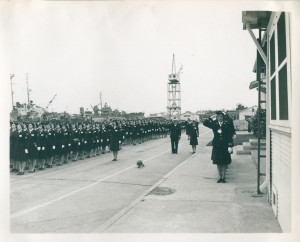WASHINGTON— As a 20-year-old student at the New England Conservatory of Music in Boston in 1944, Marion Gray made a decision that would shape the rest of her life: She joined the military.
For that era, it was an uncommon decision for a young woman. But “I felt it was a time my country needed me, and my country meant a lot to me,” said Gray, now 87 and living in Rockland, Maine.
Serving from 1944 to 1946, Gray became one of 90,000 women who played a vital role during World War II as part of the Navy Reserve’s Women Accepted for Volunteer Service, the WAVES, which was established 70 years ago Monday.
Gray served as a secretary for Eastern Sea Frontier, a Navy operational command in New York City. “We did nothing in terms of fighting, but we were fighting for our liberty at home,” she said.
The WAVES were established on July 30, 1942 to fill military jobs left vacant at home as large numbers of men were deployed to Europe and the Pacific.
While the Navy had employed women — known as “yeomanettes” — in secretarial positions during World War I, the WAVES were formed to become an integral part of the Navy Reserve, said Regina Akers, a historian a the Navy History and Heritage Command. With the establishment of the WAVES, women also were also permitted to serve in officer positions for the first time.
The WAVES program faced significant opposition by some members of Congress who were concerned about using women in the military in this new way. “The question was: ‘Women in the services? You mean other than nurses? Are you crazy?’” Akers said.
But the need for women was strong and after significant debate in Congress, legislation was passed and signed into law by President Franklin D. Roosevelt.
While World War I Navy women were placed in strictly clerical positions, the WAVES played a variety of roles in World War II. “There wasn’t an aspect of Navy business that was done in a course of a day that didn’t involve the WAVES,” Akers said. They took part in everything from pilot training and intelligence to operating the Navy’s postal service.
Large numbers of women volunteered for service because the country was united against a common threat and enemy, said Ellen Diming, 91, who served in World War II from 1944 to 1946. “Everybody knew who the enemy was, and we knew there were German U-boats patrolling the East Coast, so naturally we feared they would invade us,” she said.
Diming worked as a training instructor at Hunter College in the Bronx, which was converted into a boot camp to train WAVES during the war. As an instructor, Diming taught new WAVES how to march and follow protocol — such as making sure their hair did not touch their collars.
Women also joined the military because they felt a sense of adventure, Diming said.
Meeting women from all over the country and learning about their experiences created a close bond between WAVES, she said. “It was a uniting experience for all women in the armed services because we were all convinced we were serving our country and helping the war come to an end.”
By the end of the war, women made up about 2½ percent of the Navy force, according to the Naval History and Heritage Command.
Even before the war was over, lawmakers and the War Department began to push for the creation of a permanent place for women in the armed services, Akers said. The Women’s Armed Services Integration Act, signed into law on July 12, 1948, made it possible for women to serve as permanent members of the peacetime military.

